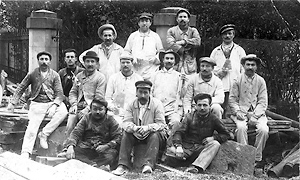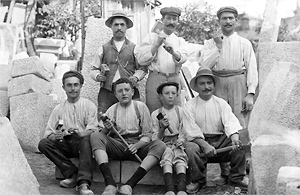Not all crafstmen were "Companions"
Let us begin with a few practical cases which will help avoid the frustrations of useless research. You find out that one or more of your ancestors were craftsmen. The first thing to do is eliminate all professions which did not include organised guild members: if an ancestor was a goldsmith, butcher, bookbinder, pot-maker, gunsmith or barber1, or practiced a trade not among those I mentioned earlier, there is no use asking whether or not he was a “Companion”.

At the same time, one needs to be careful about trades which are sometimes specialities of guild or related trades, as they could have been practised by “Companions” of the Tour de France: in the course of his career, for example, a “Companion” stonecutter could have been a paver, stone-trimmer, sculptor, mason or even an architect. Until the 19th century, the term “mason”, for example, often encompassed the work done by stonecutters, and in certain regions had a differentiated meaning, synonymous with bricklayer (as was the case with masons in the Creuse region); in the 20th century, the term came to designate a craftsman who worked in reinforced concrete. It was the use of this new material which, circa 1950, led to the foundation of the Masons’ Guild, an entity distinct from the Stonecutters’ Guild.
If, on the other hand, one discovers that an ancestor worked in a trade represented by a guild, this does not automatically mean that he was a “Companion”. Not all workers or craftsmen were necessarily guild members—far from it. As already stated, not only were guilds non-existent in several regions of France, but their members were also far from comprising the majority of workers.
If, in certain trades and in certain cities until the 1840s, it was all but obligatory to be a guild member in order to find work (as was true of carpenters in Tours), this was not at all the case with carpenters in small cities. Areas and villages left to independent, non-guild workers and where wages were lower, were referred to by guild members as “the scrubs”.

